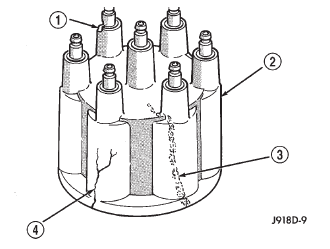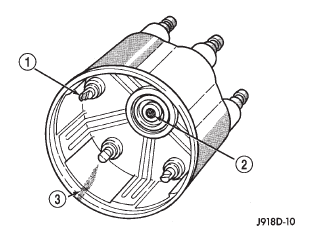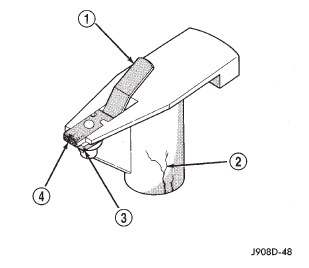Distributor cap. Distributor rotor
Remove the distributor cap and wipe it clean with
a dry lint free cloth. Visually inspect the cap for
cracks, carbon paths, broken towers or damaged
rotor button (Fig. 9) or (Fig. 10). Also check for white
deposits on the inside (caused by condensation entering entering
the cap through cracks). Replace any cap that
displays charred or eroded terminals. The machined
surface of a terminal end (faces toward rotor) will
indicate some evidence of erosion from normal operation.
Examine the terminal ends for evidence of
mechanical interference with the rotor tip.
1 - BROKEN TOWER 2 - DISTRIBUTOR CAP 3 - CARBON PATH 4 - CRACK
1 - CHARRED OR ERODED TERMINALS 2 - WORN OR DAMAGED ROTOR BUTTON 3 - CARBON PATH Visually inspect the rotor (Fig. 11) for cracks, evidence
of corrosion or the effects of arcing on the
metal tip. Also check for evidence of mechanical
interference with the cap. Some charring is normal on the end of the metal tip.
The silicone-dielectricvarnish-
compound applied to the rotor tip for radio
interference noise suppression, will appear charred.
This is normal. Do not remove the charred compound.
Test the spring for insufficient tension.
Replace a rotor that displays any of these adverse
conditions.
1 - INSUFFICIENT SPRING TENSION 2 - CRACKS 3 - EVIDENCE OF PHYSICAL CONTACT WITH CAP 4 - ROTOR TIP CORRODEDDistributor cap
 Fig. 9 Cap Inspection-External-Typical
Fig. 9 Cap Inspection-External-Typical Fig. 10 Cap Inspection-Internal-Typical
Fig. 10 Cap Inspection-Internal-TypicalDistributor rotor
 Fig. 11 Rotor Inspection-Typical
Fig. 11 Rotor Inspection-Typical
Dodge Durango (DN) 1998-2003 Service Manual
- Lubrication and Maintenance
- Suspension
- Differential and Driveline
- Brakes
- Cooling System
- Battery
- Starting Systems
- Charging System
- Ignition System
- Instrument Panel Systems
- Audio Systems
- Horn Systems
- Speed Control System
- Turn Signal and Hazard Warning Systems
- Wiper and Washer Systems
- Lamps
- Passive Restraint Systems
- Electrically Heated Systems
- Power Distribution System
- Power Lock Systems
- Vehicle Theft/Security Systems
- Power Seat System
- Power Window Systems
- Power Mirror Systems
- Chime/Buzzer Warning Systems
- Overhead Console Systems
- Engine
- Exhaust System
- Frame and Bumpers
- Fuel System
- Steering
- Transmission and Transfer Case
- Tires and Wheels
- Body
- Heating and Air Conditioning
- Emission Control Systems
- Introduction
